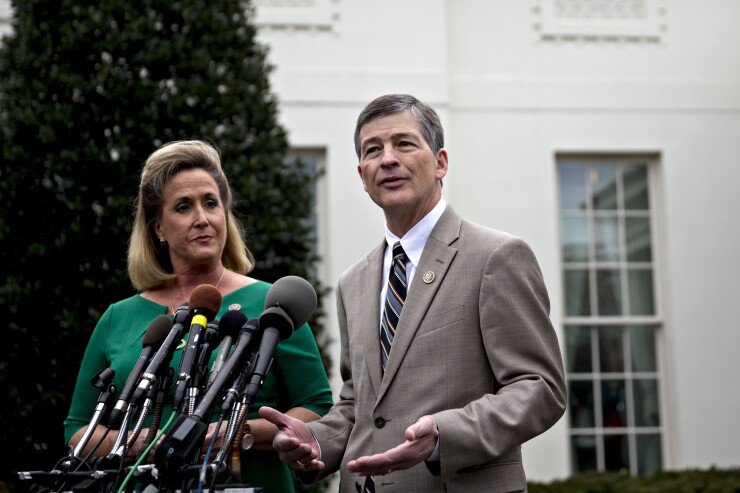Want unlimited access to top ideas and insights?
WASHINGTON — A House plan to provide regulatory relief may be more far-reaching when it is reintroduced soon by rendering the consumer protection agency toothless and providing banks with extra incentives to opt into a deregulatory plan.
The Financial Choice Act, which was introduced by House Financial Services Committee Chairman Jeb Hensarling, R-Texas, last year, centered on a provision in which banks had an “off-ramp” from complicated capital and liquidity requirements in return for holding higher capital overall. The bill cleared the panel with ease, but it had no path forward in a presidential election year.
A new draft version, which could be introduced shortly, would include added reasons for banks — particularly large institutions — to take the off-ramp, including an exemption from stress tests and a requirement to provide "living will" deregulatory plans to regulators, according to a memo reportedly from Hensarling.

But it would also go well beyond that, drastically limiting the powers of the Consumer Financial Protection Bureau, revamping how the Federal Reserve conducts stress tests for the biggest institutions and reducing the role of the Federal Deposit Insurance Corp. in the regulatory system.
The memo is dated Feb. 6, and was addressed to the leadership of the House Financial Services Committee, most likely as a point of discussion. A spokesman for Hensarling declined to confirm its accuracy.
Following is a complete list of how Hensarling is considering changing the bill, according to the memo.
CFPB changes
Among the most significant changes is that Republicans are scrapping a plan to turn the CFPB into an agency run by a commission rather than a sole director. GOP lawmakers have repeatedly suggested that the current structure creates an unaccountable consumer protection czar.
But according to the alleged Hensarling memo, Republicans would keep the sole director intact but significantly limit the agency’s powers in other ways. Among other things, it would:
- Repeal all direct supervisory authority for the bureau. Previously, Republicans had sought to change the threshold of supervision to banks with $50 billion in assets from the current $10 billion. But under the new plan, no entity would be directly supervised by the agency.
- Limit the CFPB’s enforcement powers to conducting civil investigations and issue cease-and-desist orders.
- Eliminate the CFPB's authority to file lawsuits against companies for unfair, deceptive or abusive acts or practices, known as UDAAP.
- Scrap the CFPB’s consumer complaint database. Banks have argued the database allows consumers to publish misleading or inaccurate complaints online, but the CFPB has used it to determine what areas of financial services require more oversight.
- Repeal the CFPB’s consumer education functions, market monitoring authority, mandatory advisory boards and research functions.
Stress tests
The revised bill would also target stress tests in particular. The Comprehensive Capital Analysis and Review is an annual Fed examination of big banks that takes a set of hypothetical scenarios of varyingly intense economic stress — high unemployment, negative GDP, etc. — and examines each bank’s balance sheet performance over the course of nine consecutive quarters.
If the capital ratios of any bank subject to the test — currently limited to banks with assets of more than $50 billion — drop below the required minimum, the Fed can prevent it from disbursing a dividend until it can withstand the test. The Fed can also fail banks based on a “qualitative” examination of their internal models, directing them to improve their risk management models or take other actions.
Another test, known as the Dodd-Frank Act Stress Test, operates in a similar way but uses a standardized capital management plan, and there is no penalty if banks fall below the minimum capital level.
The new version of the bill would make several changes, however, including:
- Conduct the test every two years rather than annually.
- Restrict the ability of the Fed to reject a bank’s capital plan. If an institution opted into the off-ramp and agreed to hold higher capital, that bank would be exempt from having their dividends curbed no matter how they performed in the stress test.
- Restrict the ability of the Fed to place other conditions on banks. For banks not electing the higher capital standard, the stress tests “will not be used to impose new regulations that have not been the subject of a public notice and comment period.” That could refer to longstanding
industry concerns that the stress test scenarios are in effect binding rules but are not subject to notice-and-comment periods as required by the Administrative Procedure Act.
- Eliminate the midyear DFAST runs and change its calculation. Under the bill, DFAST will “rely on a banking organizations planned capital distribution,” effectively eliminating the single most major difference between DFAST and CCAR.
- Pare down the Fed’s power to make “qualitative” objections to a plan. The bill says that the Fed “cannot use qualitative assessment test[s] as grounds for prohibiting capital distributions.”
- Adopt recommendations made in a
Government Accountability Office report last November so that they are codified in the statute. That report suggested that the Fed should be more explicit in its qualitative objections and should be somewhat more upfront in how it develops its analytical models.
Other changes
The overall thrust of the bill would allow banks that agree to a 10% leverage ratio to face an easier regulatory regime. Under the revised bill, it would remove a CAMELS component of that requirement and reduce oversight targeted at systemic risk.
Among other provisions, the bill would remove the FDIC from the living wills process entirely. The FDIC has clashed at times with the Fed over the viability of the resolution plans, and many outsiders see it as the tougher critic of the industry.





